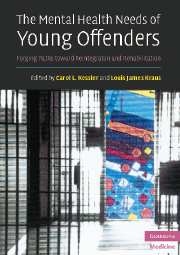Book contents
- Frontmatter
- Contents
- List of contributors
- Foreword
- Acknowledgments
- 1 An overview of child and adolescent mental health needs in the juvenile justice system
- 2 Psychiatric disorders of youth in detention
- 3 Disproportionate minority confinement
- 4 Police interrogation of youth
- 5 Assessing children's competence to stand trial and to waive Miranda rights: new directions for legal and medical decision-making in juvenile courts
- 6 The etiology of antisocial behavior: biopsychosocial risk factors across development
- 7 Substance abuse in youth offenders
- 8 Suicide and delinquent adolescents
- 9 Juvenile sex offenders
- 10 Educational needs of youth in the juvenile justice system
- 11 Science and the juvenile death penalty
- 12 Medical issues regarding incarcerated adolescents
- 13 Mental health screening and assessment in juvenile justice
- 14 Psychological testing in juvenile justice settings
- 15 Psychopharmacology and juvenile delinquency
- 16 Evidence-based treatment for justice-involved youth
- 17 Community alternatives to incarceration
- 18 Innovative problem-solving court models for justice-involved youth
- 19 Ethical issues of youthful offenders: confidentiality; right to receive and to refuse treatment; seclusion and restraint
- 20 Post-adjudicatory assessment of youth
- Index
- References
2 - Psychiatric disorders of youth in detention
Published online by Cambridge University Press: 11 August 2009
- Frontmatter
- Contents
- List of contributors
- Foreword
- Acknowledgments
- 1 An overview of child and adolescent mental health needs in the juvenile justice system
- 2 Psychiatric disorders of youth in detention
- 3 Disproportionate minority confinement
- 4 Police interrogation of youth
- 5 Assessing children's competence to stand trial and to waive Miranda rights: new directions for legal and medical decision-making in juvenile courts
- 6 The etiology of antisocial behavior: biopsychosocial risk factors across development
- 7 Substance abuse in youth offenders
- 8 Suicide and delinquent adolescents
- 9 Juvenile sex offenders
- 10 Educational needs of youth in the juvenile justice system
- 11 Science and the juvenile death penalty
- 12 Medical issues regarding incarcerated adolescents
- 13 Mental health screening and assessment in juvenile justice
- 14 Psychological testing in juvenile justice settings
- 15 Psychopharmacology and juvenile delinquency
- 16 Evidence-based treatment for justice-involved youth
- 17 Community alternatives to incarceration
- 18 Innovative problem-solving court models for justice-involved youth
- 19 Ethical issues of youthful offenders: confidentiality; right to receive and to refuse treatment; seclusion and restraint
- 20 Post-adjudicatory assessment of youth
- Index
- References
Summary
The juvenile justice system faces a significant challenge in identifying and responding to the psychiatric disorders of detained youth. In 2003, over 96 000 juvenile offenders were in custody in juvenile residential placement facilities (Sickmund et al., 2006). Despite the difficulty of handling such youth, providing them with psychiatric services may be critical to breaking the cycle of recidivism.
A comprehensive understanding of the prevalence of psychiatric disorders among juvenile detainees is an important step toward meeting their needs. Like adult prisoners, juvenile detainees with serious mental disorders have a constitutional right under the 8th and 14th Amendments to needed services (American Association of Correctional Psychology, 2000; The President's New Freedom Commission on Mental Health, 2005; Soler, 2002; Costello & Jameson, 1987). Without sound data on the prevalence of psychiatric disorders, however, defining the best means to use and enhance the juvenile justice system's scarce mental health resources is difficult.
Prior research
Although epidemiological data are key to understanding the psychiatric disorders of juvenile detainees, few empirical studies exist. Table 2.1 lists studies published in the United States since 1990 that examined the diagnostic characteristics of incarcerated and detained juveniles. These studies do not provide data that are comprehensive enough to guide juvenile justice policy. For example, although six studies present rates of multiple disorders, only four of those examine patterns of psychiatric comorbidity among juvenile detainees (Domalanta et al., 2003; Duclos et al., 1998; Pliszka et al., 2000; Shelton, 2001).
- Type
- Chapter
- Information
- The Mental Health Needs of Young OffendersForging Paths toward Reintegration and Rehabilitation, pp. 7 - 47Publisher: Cambridge University PressPrint publication year: 2007
References
- 6
- Cited by



